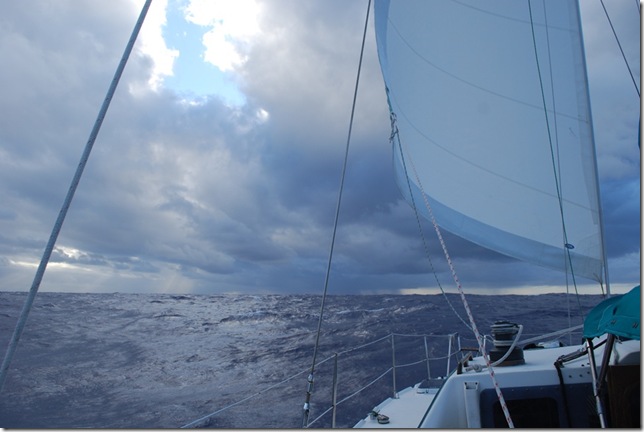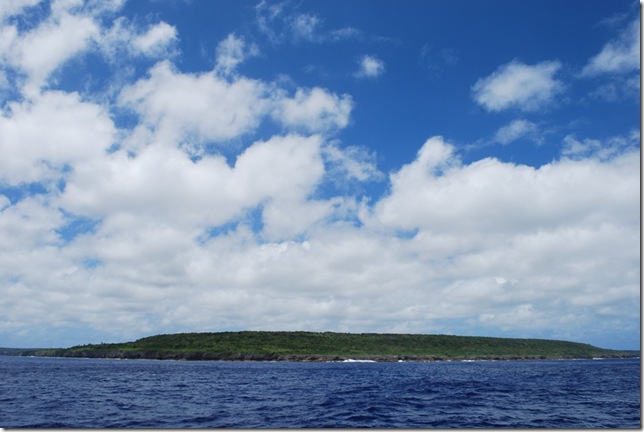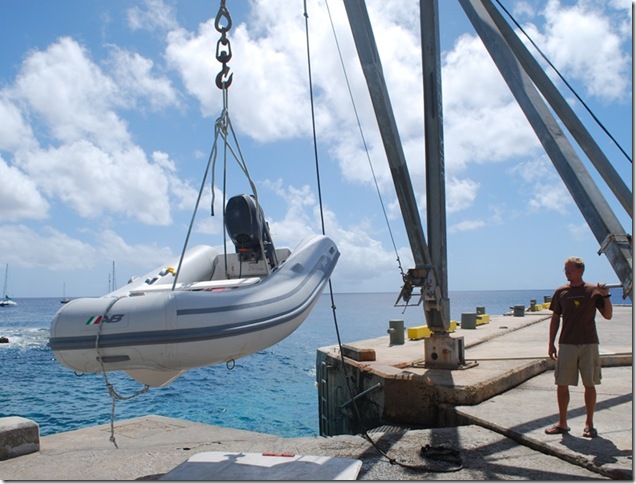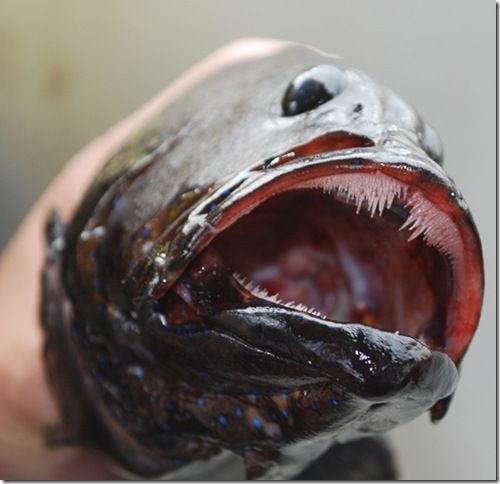Unlike the passage to Beveridge Reef, we had more than enough wind en route to Niue. Fortunately, both the wind and the large (up to 10′) waves were from astern, so the motion was not bad at all, and we averaged about 5 knots using the spinnaker or jib depending on the intensity of the wind.
At approximately 1,500 current inhabitants, Niue is the smallest country that I can think of except for the Vatican. I read that the population was over 5,000 in its heyday, but the majority of the population has chosen to take advantage of their New Zealand citizenship. Those who remain mostly work for the government, and there is also a small tourism industry created by cruisers and New Zealanders on holiday for whom the selling feature is probably the humpback whales who migrate through here, primarily in August and September. Although we are at the tail end (no pun intended) of the season, we were hoping there would be some stragglers.
Niue is a coral island of very low elevation. From a distance, it’s not very photogenic, but as we approached, we could see limestone caves spotting the coastline, giving it a more rugged look. Then as the water became more shallow, we were really impressed by the clarity of the water. Would you believe that in 100′ of water we could still see the sandy bottom?
We arrived in Niue on Sunday afternoon and were welcomed via VHF radio by our friends aboard S/V Migration and S/V Anima. Apparently the yachties aboard all but one of the 10 boats moored in the bay joined Bruce aboard Migration to celebrate his 50th birthday the night before, so this must be a fun group. As it was Sunday, we were not able to check in with customs/immigration and go ashore (they are particularly strict about it here), but that was fine with me. I couldn’t wait to jump in the crystal clear water.
First things first, though. We put up the wi-fi antenna and were able to get online and check email. Wow! In case we had any doubt that we were loved… We are just sorry that we didn’t find out about the tsumani soon enough to prevent you guys from worrying for an entire day.
Dallas and I pulled ourselves away from the computer and donned our wetsuits and weights so we could practice the free-diving techniques learned in Beveridge. We were pretty pleased with ourselves after touching the bottom in 20-25′ of water. We then snorkeled around the reef and had another close encounter with a full-grown (probably 4′ this time) white-tipped shark. Dallas’ encounter was a little closer than mine, since I was using him as a human shield! Mr. Shark had no interest in us, though, and was gone as quickly as he came. We swam around a bit more and saw a sea snake that I’ve never seen before. It was a few feet long but only about an inch thick and had black and white stripes. We also saw some grouper at the bottom that could be turned into dinner, but we need to find out which fish do/do not have ciguatera first.
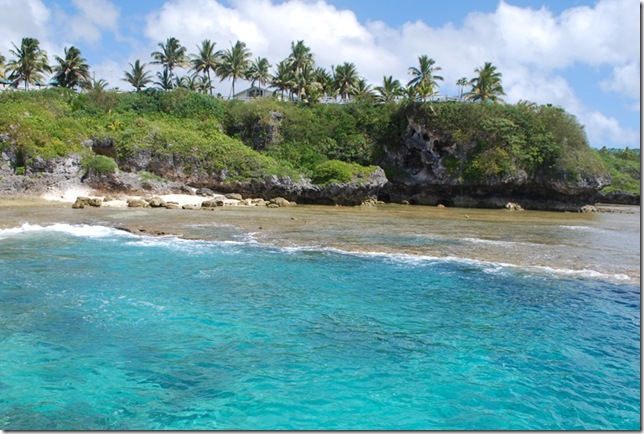 The clear water is ideal for snorkeling
The clear water is ideal for snorkeling
Martin and Wolfgang from S/V Anima stopped by in the afternoon and dropped off a loaf of fresh bread, knowing that we couldn’t go ashore. They told us all about their caving expedition the day before, which sounds like a must-do-while-in-Niue kind of thing.
We had two spectacular sights before the day was through. One was the moon rising over the bay, magnificently full and bright. The other was the unbelievable sight of two humpback whales right next to our boat!! We were just sitting in the salon having dinner when all of the sudden, we heard the unmistakable sound of air being expended through a blowhole. Tiff and I simultaneously gasped, and we all ran out into the cockpit where we saw the mother and her calf. In the bright moonlight and clear water, we could see the calf lying upside-down, showing off his white belly. I was really pumped up and shouting to the other boats, "Whale, whale!" I guess Dallas was excited, too, as he tried calling S/V Anima to let them know the whales were headed their way but pressed the wrong button on the VHF. We are hoping that we will get to see them again in daylight and get some pictures or even go for a swim with them, as some cruisers were able to do a week ago.
This morning we were boarded by the customs, quarantine, and health officers. They were very nice and asked the usual questions. It is surprising to me, though, that the only places that we have been boarded are here and tiny Swan Island, not exactly prime spots for unloading smuggled goods. Anyway, once that was said and done, Dallas and I took the dinghy ashore using the crane hoist set up for dinghies by the Niue Yacht Club, who also take care of the moorings, provide a meeting place for cruisers, have internet, and serve several varieties of ice cream (2 of which we’ve already had!).
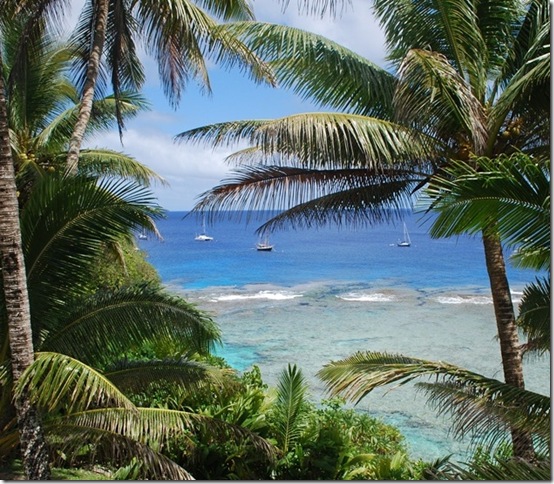 View of the mooring field from town
View of the mooring field from town
Before we head back to the boat, we will make a much-needed stop at the local grocery store. I’ve been buying mostly staples and fresh produce so far here in the Pacific, but the provisions are dwindling to the point that we might need to shell out a bit more and replenish the pantry. Fortunately the prices seem to be gradually decreasing as we near New Zealand (e.g., only $5 for a box of cereal here instead of $7 in French Polynesia).
Lat: 19 49.578′ S
Lon: 168 14.640′ W
This morning we got up around 6 am to make a couple of repairs before leaving. The bilge pump in the starboard engine room had died and had to be replaced amid several inches of greasy, oily water. That was little messy, but luckily we had a used but working bilge pump of the same model to drop in. I thought we had enough spare float switches and bilge pumps for several years, but we’ll probably buy a couple more in New Zealand. Eventually even bilge pumps succumb to life in the bilge. Next was a wiring check for the port engine water temperature gauge that had stopped working, but it looks like it was just a simple short between a couple of connections on the back of the gauge.
Lauren and I jumped in to have one last swim in the clear water and to clean off the props and grounding plates. The tide must have been high, because the current from the heavy swell that was breaking over the reef and filling the lagoon made even simple underwater tasks a lot of work. We were going to do a quick clean of the bottom, which isn’t too bad, but the current was too strong, and it was about time to leave.
We were the last boat to weigh anchor and leave Beveridge. Two boats are headed to Niue, and Matajusi is going straight to Tonga’s Vavau group. Even with a big swell from the ESE, the sailing could hardly be better. It was overcast yesterday and early this morning, but soon after exiting the boiling river of the pass, the bright tropical sun came out. So far the wind has been right around 15 knots and we’ve been making great time with the small spinnaker set. A small German boat with three people and a small baby that was born en route in Moorea left ahead of us, but once we had our spinnaker set we quickly started to overtake them. They hailed us on the radio and asked if we could take pictures of their boat, so when we get to Niue we should be able to swap pictures of our boats under sail at sea.
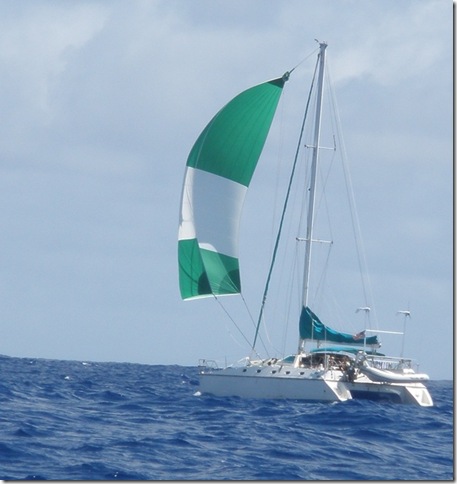 Making good time with the asymmetric spinnaker
Making good time with the asymmetric spinnaker
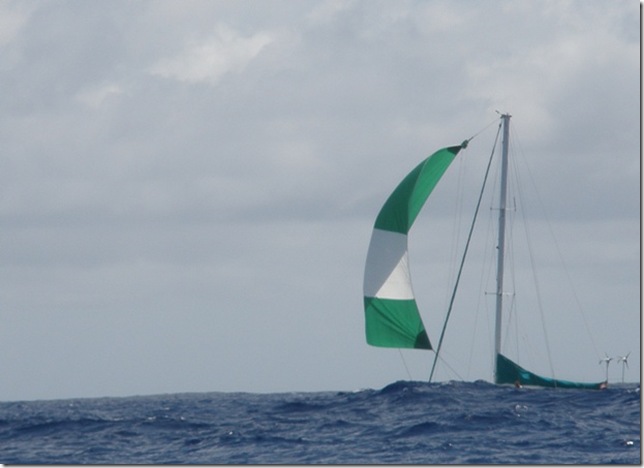 How things look when there’s a good swell running
How things look when there’s a good swell running
As much as we enjoy the time spent visiting the places we’ve stopped, it’s often nice to be back at sea. As long as the weather isn’t rough, it’s something I look forward to. I guess it’s a little bit like a day on land where you don’t have any particular plans or obligations and you can enjoy relaxing and reading about your next landfall. Lauren says it’s like a vacation from vacation, but I suppose not everyone vacations by lugging 50 lb water jugs and showers in places like Aitutaki where we had to bring a piece of hose to stick into the rusty hole in the concrete wall where cold water came out (ahhh, that was refreshing). It could also be that I just enjoy naps more than the average person.
Lauren and I were talking today about how the stop in Beveridge Reef marks one year since we quit our jobs and drove from LA to Florida to start getting the boat ready. There were so many repairs we almost missed the season, but when Silvio asked how we felt about the trip so far, we had to say it’s been well worth the working and saving. It was amazing how similar the doubts were that he and I had after we had both encountered our first storm offshore. There are some people who set out to do this with enough experience that it’s routine for them, but the majority seem to be people who are crossing an ocean for the first time as part of this trip. Even with the months and years of preparation, it’s an experience that seems to teach you something every day.
Lat: 20 00.333′ S
Lon: 167 44.740′ W
After six days of mostly light and frequently contrary winds, we finally neared Beveridge Reef at dawn Thursday. It really is just a reef, and at three miles we could barely make out the breakers with binoculars. Once we got closer, we could see five masts inside the lagoon in addition to the catamaran that was also waiting outside.
The charts of the lagoon and reef are so inaccurate that they’re useless for anything except avoiding the place, but we had photos of a couple of hand sketches with GPS co-ordinates that previous visiting boats had made. They turned out to be pretty accurate, but even though this pass was much wider than the last couple we’ve been through, coming into a completely unmarked lagoon with the sun relatively low in the sky and ahead of us had me a bit tenser than usual.
Several boats left within an hour of our arrival, leaving only the new catamaran, us, and our friends Silvio and Lilian on Matajusi. We had a nice chat with Matajusi on the radio when we got in, and Silvio let us know about the good snorkeling places and also caught us up on the tsunami news from the cruiser’s perspective. If it makes anyone feel any better, Matajusi and a number of other boats were here at the time, and they felt absolutely no effects. When they heard it had hit farther north, Silvio took Matajusi outside the lagoon and hove-to (adjusting a small sail and the rudder to “sail” with almost zero speed through the water while maintaining a fixed angle to the wind) for a while just to be safe, but he noticed nothing unusual, and the boats that stayed inside the lagoon didn’t notice anything either. Our understanding is that one sailor was killed in Samoa when he was trapped between two boats, but other than that there was only damage to a few boats that were swept onto land or rocks.
Beveridge Reef itself is a sort of kidney-shaped lagoon with pass on the west side. It’s about 30-40 feet deep in the middle with occasional coral heads. Just inside the fringing reef is a ring of coral as much about 150 feet wide, and inside that is a white sand shelf with varying width (something like a quarter mile) that is covered with about 10-12 feet of water. The water here is probably the clearest I’ve ever seen — clearer than many swimming pools. I think I could read a book on the bottom of the sand shelf while snorkeling at the surface, and we could easily see the details of the bottom as we motored over the 40-foot sections of the lagoon.
After a nap, the first order of business was to try fixing the outboard prop. Martin had suggested drilling and tapping a radial hole through the outer aluminum, through the rubber bushing, and into the inner part of the prop that attaches to the shaft, then inserting a bolt to keep the whole thing from moving. The risk is that if you hit something, you’ve defeated the sacrificial prop mechanism and could damage something more serious, but it was worth a shot for a while. Luckily, I have one tap (1/4″) on board, and the length of the required bolt turned out to be exactly 1″, which I also had. The repair was done in 15 minutes and actually worked!
We are anchored on the eastern sand shelf (coordinates above are where the boat’s at right now), and our first snorkeling stop was the inner coral ring around the reef. The coral seemed healthier here than in other places, and there was a nice selection of fish, but the current from the thundering waves breaking on the reef and then sweeping into the lagoon was so bad that it was hard to swim forward at times, and Lauren and I definitely got a workout. I took a Hawaiian sling (6-foot spear with a 1-foot band of rubber on the other end) to try catching a grouper or parrotfish, and we had a lot of fun with that. You have to be pretty close to get anything with the sling, and it was so dull that when I finally did get a good shot on a grouper through a hole in the coral, the spear bounced off of him. Using a sling to catch a parrotfish is not a fair game at all. They’re much more skiddish, and very agile and quick, so with the strong current, that was just a long game of wear-Dallas-out.
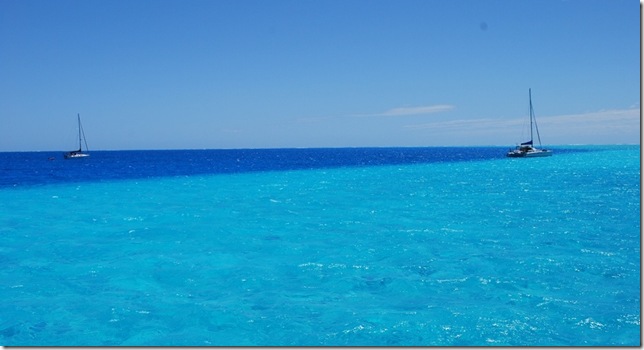 Matajusi is the boat on the left. The light water is about 10-12 ft deep above the sandy shelf and the darker water is about 40 feet deep.
Matajusi is the boat on the left. The light water is about 10-12 ft deep above the sandy shelf and the darker water is about 40 feet deep.
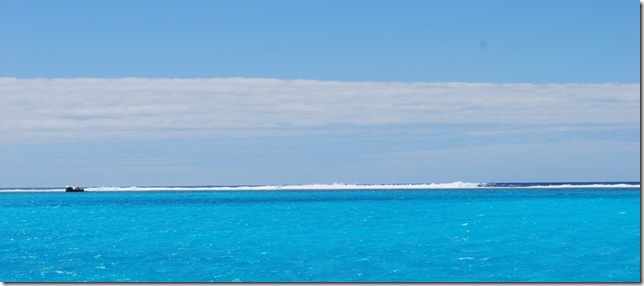 The breakers on the reef just east of where we were anchored. The wreck was an offshore fishing boat.
The breakers on the reef just east of where we were anchored. The wreck was an offshore fishing boat.
We took a break back at the boat and then headed out for another area of the fringing coral. This time, I had sharpened the spear and was ready for another round with the purple-spotted groupers. Unfortunately, the prop fix failed on the way over, so we’re back to idle speed until I try another fix or get a new prop. I’m not quite sure how that happened, but I’ll pull it apart and see. The story was pretty much the same this time, but I did eventually manage to hit a nice-sized grouper right in the side while he was hiding under some coral. To my amazement, he shook until he was off of the tip of the spear and then swam off into the coral catacombs. Not only are fish fast and agile, they’re also very tough. Ah well, no grouper dinner for the non-vegetarians.
After sunset we headed over to Matajusi for a nice evening of a few drinks, conversation, and sharks-sticks (fish sticks made with Beveridge Reef shark). Lauren really liked them, but I don’t think I’ll take up trying to spear the white tips in the lagoon for her culinary benefit any time soon. Silvio was a competition-level free diver and spear fisherman and has some amazing stories. He also taught us some breathing techniques that should give us a better shot. I don’t think we’ll be imitating his 3-4 minute dives down to as deep at 30 meters anytime soon, but there may be a fresh fish dinner in it at some point. I think we’ll also skip the hyperventilating technique he used in competition when he was younger that resulted in a vision black-out for the first 6-7 meters of most dives.
Today we got a chance to go spear-fishing with Silvio in the deeper part of the lagoon just behind his boat. That pretty much consisted of Lauren and I trying to get halfway down to the bottom almost 40 feet below while Silvio went down at will, hung out for a while, and speared fish (did we mention Silvio’s 61st birthday was in Aitutaki last week?). His breathing techniques definitely helped, but neither of us could equalize fast enough to get close to the bottom without hurting our ears. Meanwhile, he speared two jacks, three small grouper, and another red fish for us to enjoy for dinner (Lauren & Tiff report that the jack sashimi is excellent). We finally saw our first shark when we were out in the water on our own. It was about 5 feet long, but as it didn’t get too close it was actually not too intimidating.
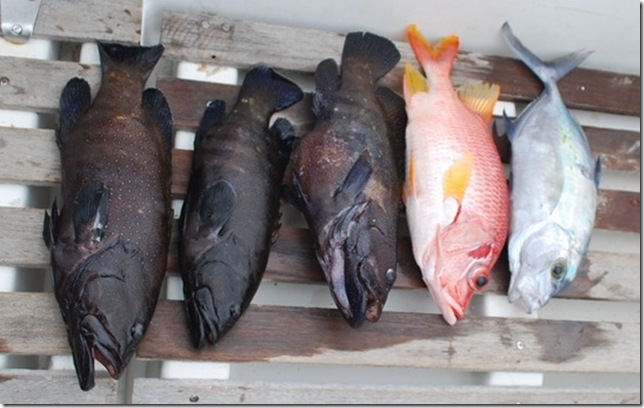 Silvio’s catch (groupers on the left and jack on the right)
Silvio’s catch (groupers on the left and jack on the right)
One of the jacks Silvio shot at was actually one of a pair swimming just above a stingray. Evidently the jacks eat the shrimp that are stirred up by the stingray as it swims along the bottom. Even though he waited for just the right moment to shoot the jack and miss the ray, from the surface it looked like he was shooting the ray, and it took its tail-up defensive posture on the bottom right after he shot. It’s interesting to hear about the behavior of the different fish and how to take advantage of that to spear them. For instance, with a grouper you usually have 3 seconds after it sees you to make a shot before it swims into cover. With a red snapper, wait for the 3rd time it comes back to check you out. With a jack, leave the speared fish near the bottom and other jacks will come around, allowing you to pick a bigger one and take them both home.
After a big rain storm last night, the weather is looking good, so tonight will be our last night here. We’ll start the 140 nm passage to Niue tomorrow morning. If things go as planned, we only have about 4 days of sailing left before we leave for New Zealand (1 day to Niue, 2 days to Tonga – Vavau, and 1 day to Tonga – Nukualofa).
Dallas and I got our first big break (haha) thanks to knowing people in high places in Boston. We have a small piece about our experience in Swan Island in the October issue of SAIL magazine. It should be in newsstands right now for those of you who would like to check it out. Hopefully there will be more to come.


